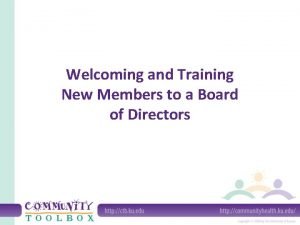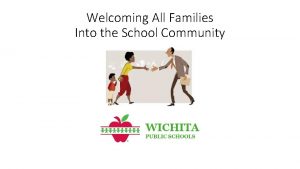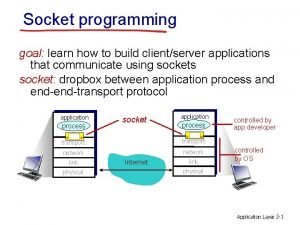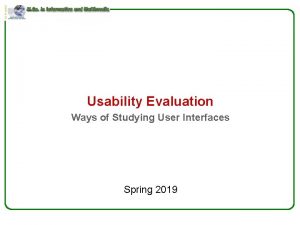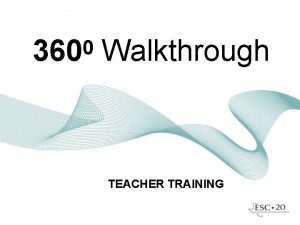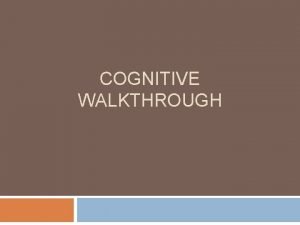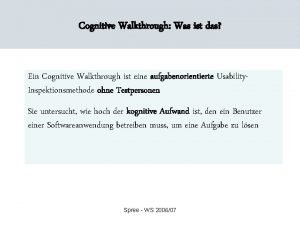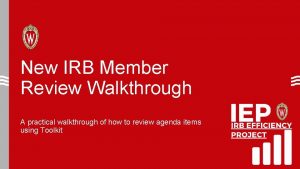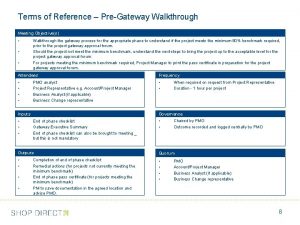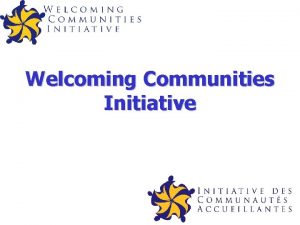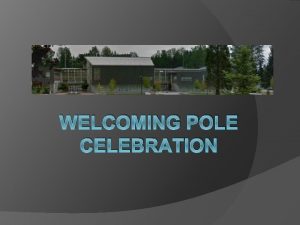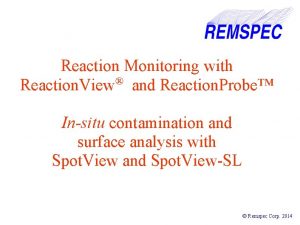The Welcoming Walkthrough Think of your initial reaction















- Slides: 15

The Welcoming Walkthrough {

Think of your initial reaction when you enter your child’s new school if: • There is litter on the grounds surrounding the building and/or graffiti on the walls • There are broken windows • You can’t find the way to get into the building • Once inside the building, you can’t find the office

Then , once inside the office, • You want help, but you are ignored while people stand around having a conversation, and you hear negative comments about students and their parents • You also see a staff member reprimanding a student for bad behavior – all of this in front of other adults and students • You finally begin saying that you are very upset about something, but the person who greets you is too busy to try to understand how you feel

What would your first impression of this school be?

The Welcoming Walkthrough is an assessment of the school that is conducted by a team of school staff, parents and community partners. (The principal is usually not included. ) The team assesses specific elements of school life, and it develops a report that lists the school’s commendations and recommendations, and that serves as the starting point for plans to develop a more welcoming atmosphere.

Category 1: Physical Environment Signage to the main entrance, to the office, etc. Directory of key school staff Welcoming sign near the entrance, preferably in more than one language Cleanliness – inside and outside the building Inviting displays in public areas of the school

Category 2: Public Relations The way visitors are greeted The way staff interact with one another The way staff address student misbehavior (should be done with dignity) The way confidential information is protected (never discussed publicly) The way staff talk about one another, about students, about parents The attention staff give to calls and messages from parents

Category 3: School Practices and Policies Information packets available for families new to the school Teacher calls to students’ families to report positive news about their students The staff’s attention to communication with non-custodial parents The staff’s efforts to help staff and parents become acquainted during the year The staff’s efforts to pronounce parents’ and students’ names correctly The school’s policy and practice to address student misbehavior individually, privately and with dignity

Category 4: Written Materials Newsletters, parent handbook and other means of communications with the school community Written materials for parents and the community that are free of educational jargon or terms, as well as unfamiliar abbreviations Written materials that are prepared in more than one language Clearly explained descriptions of the school’s educational and extra-curricular programs

To conduct the Welcoming Walkthrough, the participants divide themselves into four teams, one representing each section of the survey. Each team should have 1 or 2 staff members and 2 or 3 parents/community members, and each team does only one section of the survey. It is permissible for someone to serve on more than one team, but then the teams will have to do their surveys at different times. Physical Environment (1 or 2 staff members & 2 or 3 parents/community members) 20 item survey Public Relations (1 or 2 staff members & 2 or 3 parents/community members) 14 item survey School-wide Practices and Policies (1 or 2 staff members & 2 or 3 parents/community members) 21 item survey Written Materials (1 or 2 staff members & 2 or 3 parents/community members) 16 item survey In addition to completing its checklist, each team also identifies its commendations and recommendations

Why Is it Important to Be a Welcoming School? School invitingness has been shown to be a very consistent predictor of parent involvement. This is good news because the school climate is something that staff can change. An inviting atmosphere is especially important to making stronger connections with families of children with disabilities, or in communities with diverse culture, language and economic factors.

Why Do Families Become Involved? Children’s success in school can be influenced by their parents’ attitudes and beliefs about education. Their beliefs are influenced by: • Their sense of efficacy – the belief in their own capabilities and their ability to make a difference in their child’s success in school. • Their understanding of a parent’s role – their beliefs about how their children develop and what a parent’s responsibility is in that development, especially as it pertains to schooling. • The invitation they receive from the school– whether they have been encouraged by their children and the staff to become involved and shown what they can do to help their children’s success in school.

Educators understand more than ever that the key to engaging parents is to make their schools feel like families to which they also belong. Schools that extend a genuine welcome to parents have strong partners in the education process, with parents much more likely to be involved at the school level and to help their children at home, too.

What do “Welcoming Schools” Do Right? • They make sure “Welcoming” is an active, ongoing process. It doesn’t end once the survey ends. • They honor the contributions of all families no matter how large or small, from volunteering at the school to helping their children at home. • They show parents they are respected through frequent “twoway” communication in language parents understand, and they address parents’ specific needs and concerns. • They connect family engagement efforts to student learning and help parents understand curriculum expectations and student work.

FIRST IMPRESSIONS MATTER LET’S MAKE THEM GOOD IMPRESSIONS
 Think big think fast think ahead
Think big think fast think ahead Welcome tourist
Welcome tourist Assisting guests
Assisting guests What is the kingdom of god in the old testament
What is the kingdom of god in the old testament Welcome board members
Welcome board members Welcoming all families into the school community
Welcoming all families into the school community Dua for welcoming ramadan
Dua for welcoming ramadan Welcoming socket
Welcoming socket Closing prayer
Closing prayer Inital rate
Inital rate Why does bob ewell lose his wpa job
Why does bob ewell lose his wpa job Why according to robin and jay are people funny
Why according to robin and jay are people funny Think fam think
Think fam think Objectives in immersion
Objectives in immersion Cognitive walkthrough vs heuristic evaluation
Cognitive walkthrough vs heuristic evaluation Openflow install
Openflow install




